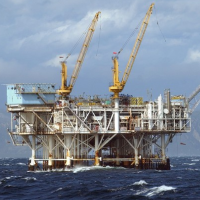While Fracking on Land Comes Under Fire, Energy Companies Quietly Do It Offshore
 Drilling off the coast of Santa Barbara (photo: Steve Malone, Associated Press)
Drilling off the coast of Santa Barbara (photo: Steve Malone, Associated Press)
While debate rages in California and the nation over the safety of fracking for oil and gas on land, drillers have already used it to crack open the ocean floor and inject thousands of gallons of pressurized water, sand and chemicals into the Earth.
The Associated Press reported last week that at least a dozen permits have been issued by the state since the late ‘90s for offshore use of the controversial process, formally known as hydraulic fracturing. The drilling is taking place in Santa Barbara waters, where a giant oil spill in 1969 prompted a state moratorium on new offshore oil leases all along the coast.
The report follows stories stretching back to 2012 by online journalists at Truthout detailing two of the fracking operations and federal acquiescence in their relatively unregulated procedures. According to the AP, federal agencies conduct some inspections, but spills or leaks are pretty much left to the oil companies to report.
The state moratorium hasn’t stopped energy companies from shifting their existing drilling operations to fracking, which allows companies to extract oil and gas that would be otherwise inaccessible, with approval from the federal government. The latest approved ocean fracking is 10 miles off the coast of Ventura County, where an oil and gas company received permission in March to drill a new well using an old wellbore.
Although fracking has been used in a limited fashion across the country for decades, it has only recently been receiving attention as energy companies attempt to reinvigorate depleted oil and gas wells using new technology. It is coming under increased scrutiny in California as the state ponders tapping the Monterey Shale in Central California, a repository of oil that could top 15.3 billion barrels and may represent 60% of all shale oil in the country.
Six of the 12 offshore fracking sites detected by the AP involved tapping the Monterey Shale in 2010. According to documents obtained from the Bureau of Safety and Environmental Enforcement (BSEE), the Venoco Inc. oil and gas company pumped 300,000 pounds of sand, salt water and chemicals into the seabed in what was termed a mildly successful endeavor.
The federal government doesn’t require that fracking chemicals meet national clean water standards, allowing drillers to avoid filing environmental impact reports on their operations. The U.S. Environmental Protection Agency (EPA) agrees with energy companies that their treatment of fracking waste water, which is discharged back into the sea, and self-reporting of any spills is sufficient to protect the environment, according to the AP.
But California regulators told the AP that this is all news to them: “It wasn't on our radar before, and now it is,” Alison Dettmer, a deputy director at the California Coastal Commission,” told reporters.
Fracking is largely unregulated in California, although the Legislature and state regulators are considering new rules that would compel companies to reveal where they are fracking, what kinds of chemicals they are pumping into the ground and the environmental ramifications of their efforts. Fracking has been linked to groundwater contamination, air pollution, releases of methane gas, micro-earthquakes and sink holes.
–Ken Broder
To Learn More:
Fracking off California Coast Draws Call for Greater Regulation (by Jason Dearen and Alicia Chang, Associated Press)
Fracking in the Ocean off the California Coast (by Mike Ludwig, Truthout)
Scientists Envision Fracking in Arctic and on Ocean Floor (by Ben Lefebvre, Wall Street Journal)
Are “Acid Jobs” a Bigger Environmental Threat than Fracking for Oil and Gas? (by Ken Broder, AllGov California)
- Top Stories
- Controversies
- Where is the Money Going?
- California and the Nation
- Appointments and Resignations
- Unusual News
- Latest News
- California Forbids U.S. Immigration Agents from Pretending to be Police
- California Lawmakers Urged to Strip “Self-Dealing” Tax Board of Its Duties
- Big Oil’s Grip on California
- Santa Cruz Police See Homeland Security Betrayal in Use of Gang Roundup as Cover for Immigration Raid
- Oil Companies Face Deadline to Stop Polluting California Groundwater





